Investigations of Effects of Intermetallic Compound on the Mechanical Properties and Shape Memory Effect of Ti–Au–Ta Biomaterials
Abstract
1. Introduction
2. Materials and Methods
3. Results and Discussion
3.1. Cold Workability
3.2. Phase Identification
3.3. Microstructure Observations and Elemental Mappings
3.4. Bending Test
3.5. Continuous Tensile Tests
3.6. Functional Mapping
3.7. Cyclic Loading–Unloading Tensile Tests
4. Conclusions
- The single parent β–phase was found in the Ti–4Au–20Ta alloy while the parent β–phase along with the precipitates of the Ti3Au intermetallic compound in a volume fraction of approximate 5% was observed in the Ti–4Au–30Ta alloy.
- The Ti–4Au–20Ta alloy showed about 30% shape recovery upon heating in the bending tests while only 10% shape recovery was found in the Ti–4Au–30Ta alloy due to the inhibition of phase transformation between austenite and martensite from the Ti3Au precipitates.
- An obvious two–stage yielding, which corresponds to the stress for the stress–induced martensite transformation (SIMT) and the stress for plastic deformation, was found in the Ti–4Au–20Ta alloy. On the other hand, no obvious two–stage yielding was found in the Ti–4Au–30Ta alloy due to the inhibition of SIMT from the Ti3Au intermetallic compound.
- In the continuous tensile test, the strength of the Ti–4Au–30Ta alloy was higher than that of the Ti–4Au–20Ta alloy due to the truth of the solid–solution hardening effect from the Ta addition as the third element and the precipitation hardening effect from the Ti3Au intermetallic compound. On the contrary, better elongation was found in the Ti–4Au–20Ta alloy than that of the Ti–4Au–30Ta alloy owing to the SIMT and no precipitation of Ti3Au compound.
- Slight pseudoelasticity at approximately 0.5% was found in the Ti–4Au–20Ta alloy showing slight shape recovery after unloading of externally applied stress while almost no shape recovery was found in the Ti–4Au–30Ta alloy due to the inhibition of Ti3Au precipitates. These results are in accordance with the bending tests and the continuous tensile tests.
Author Contributions
Funding
Institutional Review Board Statement
Informed Consent Statement
Data Availability Statement
Conflicts of Interest
References
- Jani, J.M.; Leary, M.; Subic, A.; Gibson, M.A. A review of shape memory alloy research, applications and opportunities. Mater. Des. 2014, 56, 1078–1113. [Google Scholar] [CrossRef]
- Yamauchi, K.; Ohkata, I.; Tsuchiya, K.; Miyazaki, S. Shape Memory and Superelastic Alloys: Applications and Technologies; Elsevier: Amsterdam, The Netherlands, 2011. [Google Scholar]
- Morgan, N.B. Medical shape memory alloy applications—the market and its products. Mater. Sci. Eng. A 2004, 378, 16–23. [Google Scholar] [CrossRef]
- Fang, C.; Wang, W. Shape Memory Alloys for Seismic Resilience; Springer: New York, NY, USA, 2020. [Google Scholar]
- Magnusson, B.; Bergman, M.; Bergman, B.; Söremark, R. Nickel allergy and nickel-containing dental alloys. Eur. J. Oral Sci. 1982, 90, 163–167. [Google Scholar] [CrossRef] [PubMed]
- Christensen, O.B.; Möoller, H. External and internal exposure to the antigen in the hand eczema of nickel allergy. Contact Derm. 1975, 1, 136–141. [Google Scholar] [CrossRef] [PubMed]
- Li, Y.; Yang, C.; Zhao, H.; Qu, S.; Li, X.; Li, Y. New Developments of Ti-Based Alloys for Biomedical Applications. Materials 2014, 7, 1709–1800. [Google Scholar] [CrossRef]
- Biesiekierski, A.; Wang, J.; Gepreel, M.A.-H.; Wen, C. A new look at biomedical Ti-based shape memory alloys. Acta Biomater. 2012, 8, 1661–1669. [Google Scholar] [CrossRef]
- Eisenbarth, E.; Velten, D.; Müller, M.; Thull, R.; Breme, J. Biocompatibility of β-stabilizing elements of titanium alloys. Biomaterials 2004, 25, 5705–5713. [Google Scholar] [CrossRef]
- Ratner, B.D. A Perspective on Titanium Biocompatibility. In Titanium in Medicine; Engineering Materials; Springer: Berlin/Heidelberg, Germany, 2001. [Google Scholar]
- Wataha, J.C. Biocompatibility of dental casting alloys: A review. J. Prosthet. Dent. 2000, 83, 223–234. [Google Scholar] [CrossRef]
- Hainfeld, J.F.; Slatkin, D.N.; Focella, T.M.; Smilowitz, H.M. Gold nanoparticles: A new X-ray contrast agent. Br. J. Radiol. 2006, 79, 248–253. [Google Scholar] [CrossRef]
- Goodman, P. Current and future uses of gold in electronics. Gold Bull. 2002, 35, 21–26. [Google Scholar] [CrossRef]
- Hanawa, T. In vivo metallic biomaterials and surface modification. Mater. Sci. Eng. A 1999, 267, 260–266. [Google Scholar] [CrossRef]
- Plichta, M.R.; Williams, J.C.; Aaronson, H.I. On the existence of the β → αm transformation in the alloy systems Ti–Ag, Ti–Au, and Ti–Si. Metall. Trans. A 1977, 8, 1885–1892. [Google Scholar] [CrossRef]
- Plichta, M.R.; Perepezko, J.H.; Aaronson, H.I.; Lange, W.F. Part I Nucleation kinetics of the β → αm transformation in Ti–Ag and Ti–Au alloys. Acta Metall. 1980, 28, 1031–1040. [Google Scholar] [CrossRef]
- Murray, J.L. Phase Diagrams of Binary Titanium Alloys; ASM International: Materials Park, OH, USA, 1987. [Google Scholar]
- Soro, N.; Attar, H.; Brodie, E.; Veidt, M.; Molotnikov, A.; Dargusch, M.S. Evaluation of the mechanical compatibility of additively manufactured porous Ti–25Ta alloy for load-bearing implant applications. J. Mech. Behav. Biomed. Mater. 2019, 97, 149–158. [Google Scholar] [CrossRef]
- Meisner, L.L.; Markov, A.B.; Rotshtein, V.P.; Ozur, G.E.; Meisner, S.N.; Yakovlev, E.V.; Semin, V.O.; Mironov, Y.P.; Poletika, T.M.; Girsova, S.L.; et al. Microstructural characterization of Ti-Ta-based surface alloy fabricated on TiNi SMA by additive pulsed electron-beam melting of film/substrate system. J. Alloys Compd. 2018, 730, 376–385. [Google Scholar] [CrossRef]
- Liu, Y.; Li, K.; Wu, H.; Song, M.; Wang, W.; Li, N.; Tang, H. Synthesis of Ti–Ta alloys with dual structure by incomplete diffusion between elemental powders. J. Mech. Behav. Biomed. Mater. 2015, 51, 302–312. [Google Scholar] [CrossRef]
- He, W.; Ai, K.; Lu, L. Nanoparticulate X-ray CT contrast agents. Sci. China Chem. 2015, 58, 753–760. [Google Scholar] [CrossRef]
- Jin, Y.; Li, Y.; Ma, X.; Zha, Z.; Shi, L.; Tian, J.; Dai, Z. Encapsulating tantalum oxide into polypyrrole nanoparticles for X-ray CT/photoacoustic bimodal imaging-guided photothermal ablation of cancer. Biomaterials 2014, 35, 5795–5804. [Google Scholar] [CrossRef] [PubMed]
- Yang, C.; Li, J.; Zhu, C.; Zhang, Q.; Yu, J.; Wang, J.; Wang, Q.; Tang, J.; Zhou, H.; Shen, H. Advanced antibacterial activity of biocompatible tantalum nanofilm via enhanced local innate immunity. Acta Biomater. 2019, 89, 403–418. [Google Scholar] [CrossRef]
- Matsuno, H.; Yokoyama, A.; Watari, F.; Uo, M.; Kawasaki, T. Biocompatibility and osteogenesis of refractory metal implants, titanium, hafnium, niobium, tantalum and rhenium. Biomaterials 2001, 22, 1253–1262. [Google Scholar] [CrossRef]
- Niinomi, M. Mechanical properties of biomedical titanium alloys. Mater. Sci. Eng. A 1998, 243, 231–236. [Google Scholar] [CrossRef]
- Zarinejad, M.; Wada, K.; Pahlevani, F.; Katal, R.; Rimaz, S. Martensite and reverse transformation temperatures of TiAu-based and TiIr-based intermetallics. J. Alloys Compd. 2021, 870, 159399. [Google Scholar] [CrossRef]
- Casalena, L.; Bigelow, G.S.; Gao, Y.; Benafan, O.; Noebe, R.D.; Wang, Y.; Mills, M.J. Mechanical behavior and microstructural analysis of NiTi-40Au shape memory alloys exhibiting work output above 400 °C. Intermetallics 2017, 86, 33–44. [Google Scholar] [CrossRef]
- Wu, S.K.; Wayman, C.M. Martensitic transformations and the shape memory effect in Ti50Ni10Au40 and Ti50Au50 alloys. Metallography 1987, 20, 359–376. [Google Scholar] [CrossRef]
- Kikuchi, M.; Takahashi, M.; Okuno, O. Elastic moduli of cast Ti–Au, Ti–Ag, and Ti–Cu alloys. Dent. Mater. 2006, 22, 641–646. [Google Scholar] [CrossRef]
- Buenconsejo, P.J.S.; Kim, H.Y.; Hosoda, H.; Miyazaki, S. Shape memory behavior of Ti–Ta and its potential as a high-temperature shape memory alloy. Acta Mater. 2009, 57, 1068–1077. [Google Scholar] [CrossRef]
- Ikeda, M.; Komatsu, S.-Y.; Nakamura, Y. The Effect of Ta Content on Phase Constitution and Aging Behavior of Ti-Ta Binary Alloys. Mater. Trans. 2002, 43, 2984–2990. [Google Scholar] [CrossRef][Green Version]
- Kim, H.Y.; Fukushima, T.; Buenconsejo, P.J.S.; Nam, T.-H.; Miyazaki, S. Martensitic transformation and shape memory properties of Ti–Ta–Sn high temperature shape memory alloys. Mater. Sci. Eng. A 2011, 528, 7238–7246. [Google Scholar] [CrossRef]
- Bertrand, E.; Castany, P.; Yang, Y.; Menou, E.; Gloriant, T. Deformation twinning in the full-α″ martensitic Ti–25Ta–20Nb shape memory alloy. Acta Mater. 2016, 105, 94–103. [Google Scholar] [CrossRef]
- Buenconsejo, P.J.S.; Kim, H.Y.; Miyazaki, S. Effect of ternary alloying elements on the shape memory behavior of Ti–Ta alloys. Acta Mater. 2009, 57, 2509–2515. [Google Scholar] [CrossRef]
- Chiu, W.-T.; Ishigaki, T.; Nohira, N.; Umise, A.; Tahara, M.; Hosoda, H. Effect of 3d transition metal additions on the phase constituent, mechanical properties, and shape memory effect of near–eutectoid Ti–4Au biomedical alloys. J. Alloys Compd. 2021, 857, 157599. [Google Scholar] [CrossRef]
- Chiu, W.-T.; Wakabayashi, K.; Umise, A.; Tahara, M.; Hosoda, H. Enhancement of Mechanical Properties and Shape Memory Effect of Ti–Cr–based Alloys via Au and Cu Modifications. J. Mech. Behav. Biomed. Mater. 2021, 123, 104707. [Google Scholar] [CrossRef]
- Murray, J.L. The Au–Ti (Gold–Titanium) system. Bull. Alloy Phase Diagr. 1983, 4, 278–283. [Google Scholar] [CrossRef]
- Chiu, W.-T.; Ishigaki, T.; Nohira, N.; Umise, A.; Tahara, M.; Inamura, T.; Hosoda, H. Influence of the precipitates on the shape memory effect and superelasticity of the near–eutectoid Ti–Au–Fe alloy towards biomaterial applications. Intermetallics 2021, 133, 107180. [Google Scholar] [CrossRef]
- Kim, H.Y.; Hashimoto, S.; Kim, J.I.; Inamura, T.; Hosoda, H.; Miyazaki, S. Effect of Ta addition on shape memory behavior of Ti–22Nb alloy. Mater. Sci. Eng. A 2006, 417, 120–128. [Google Scholar] [CrossRef]
- Ijaz, M.F.; Zhukova, Y.; Konopatsky, A.; Dubinskiy, S.; Korobkova, A.; Pustov, Y.; Brailovski, V.; Prokoshkin, S. Effect of Ta addition on the electrochemical behavior and functional fatigue life of metastable Ti-Zr-Nb based alloy for indwelling implant applications. J. Alloys Compd. 2018, 748, 51–56. [Google Scholar] [CrossRef]
- Chiu, W.-T.; Ishigaki, T.; Nohira, N.; Umise, A.; Tahara, M.; Inamura, T.; Hosoda, H. Effect of Cr additions on the phase constituent, mechanical properties, and shape memory effect of near–eutectoid Ti–4Au towards the biomaterial applications. J. Alloys Compd. 2021, 867, 159037. [Google Scholar] [CrossRef]
- Karimi, A.; Cattin, C. Intermetallic β-Ti3Au hard thin films prepared by magnetron sputtering. Thin Solid Films 2018, 646, 1–11. [Google Scholar] [CrossRef]
- Chiu, W.-T.; Ishigaki, T.; Nohira, N.; Umise, A.; Tahara, M.; Inamura, T.; Hosoda, H. Evaluations of mechanical properties and shape memory behaviors of the aging–treated Ti–Au–Mo alloys. Mater. Chem. Phys. 2021, 269, 124775. [Google Scholar] [CrossRef]
- Xin, Y.; Han, K.; Svanidze, E.; Besara, T.; Siegrist, T.; Morosan, E. Microstructure of hard biocompatible Ti1−xAux alloys. Mater. Charact. 2019, 149, 133–142. [Google Scholar] [CrossRef]
- Bhadeshia, H.K.D.H.; Wayman, C.M. Phase Transformations: Nondiffusive. In Physical Metallurgy, 5th ed.; Elsevier: Amsterdam, The Netherlands, 2014; pp. 1021–1072. [Google Scholar]
- Popov, P.; Lagoudas, D.C. A 3-D constitutive model for shape memory alloys incorporating pseudoelasticity and detwinning of self-accommodated martensite. Int. J. Plast. 2007, 23, 1679–1720. [Google Scholar] [CrossRef]
- Otsuka, K.; Wayman, C.M. Shape Memory Materials; Cambridge University Press: Cambridge, UK, 1999. [Google Scholar]
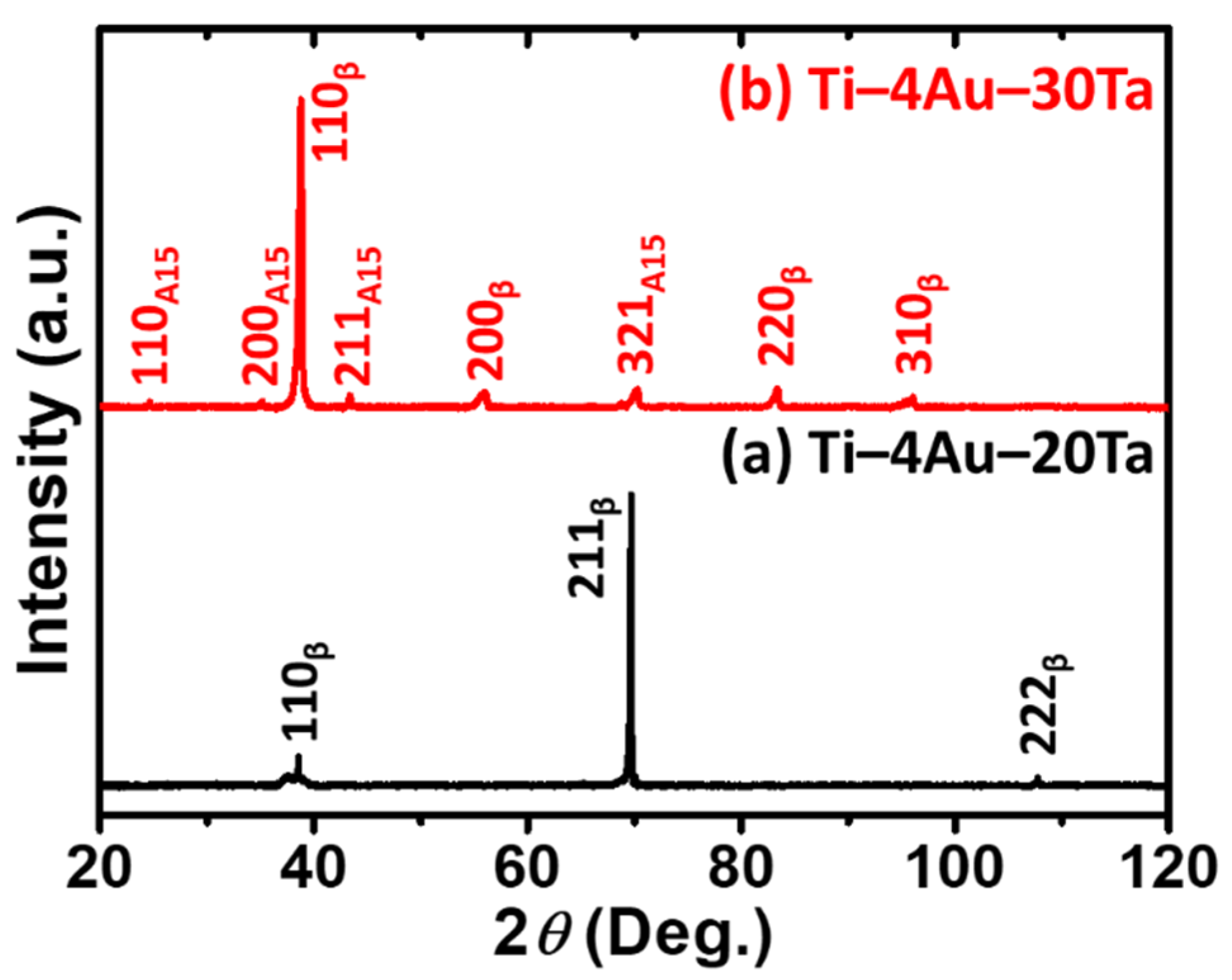
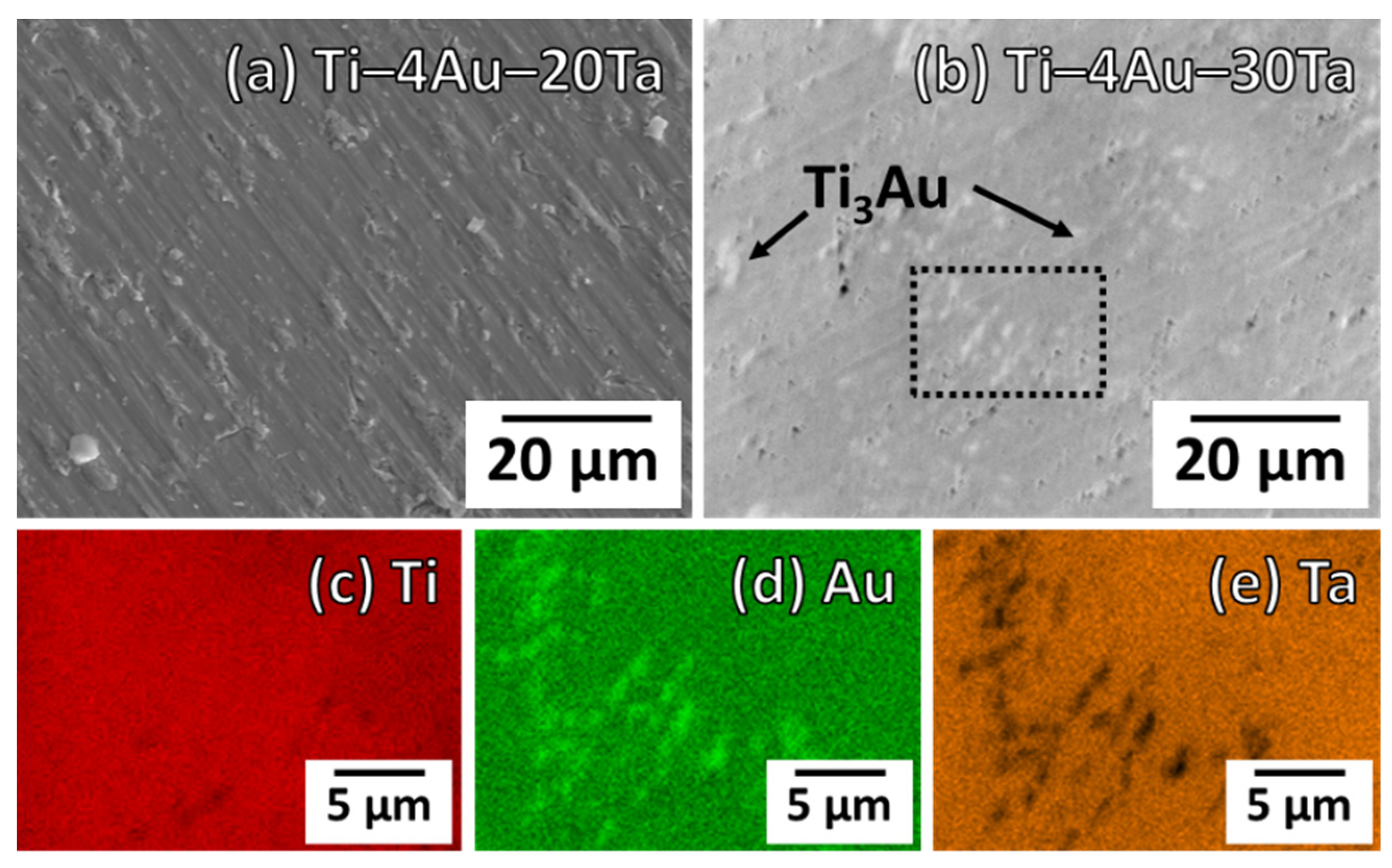
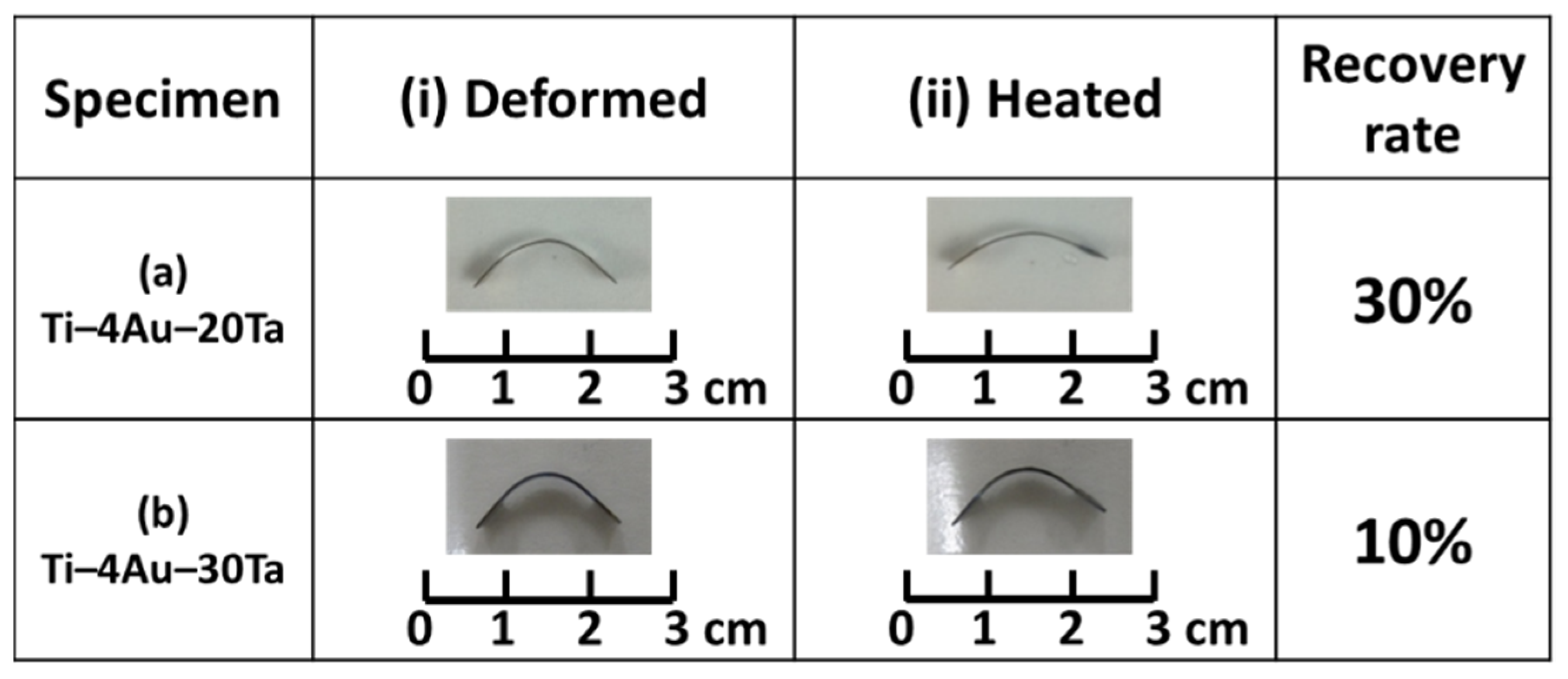
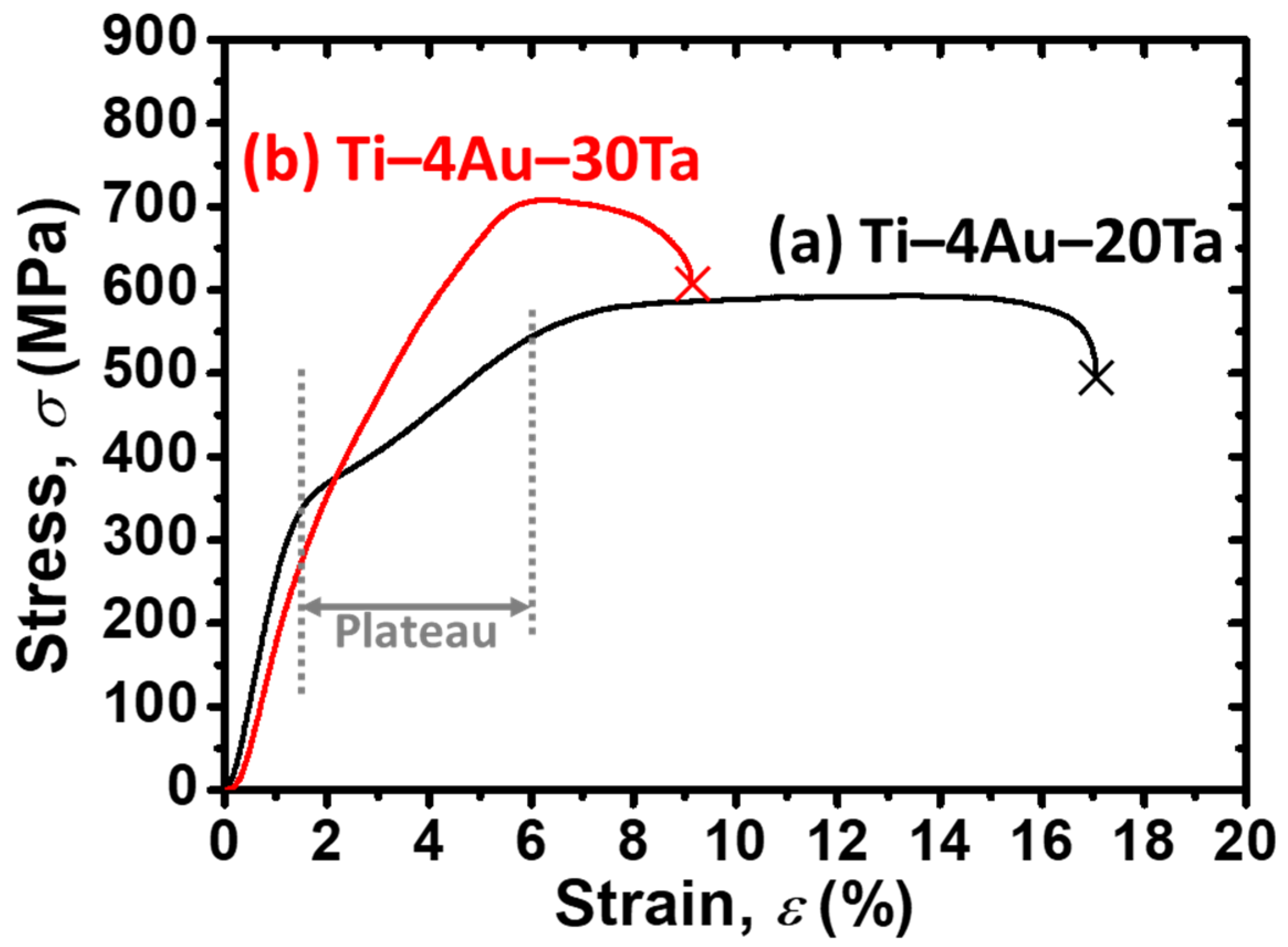
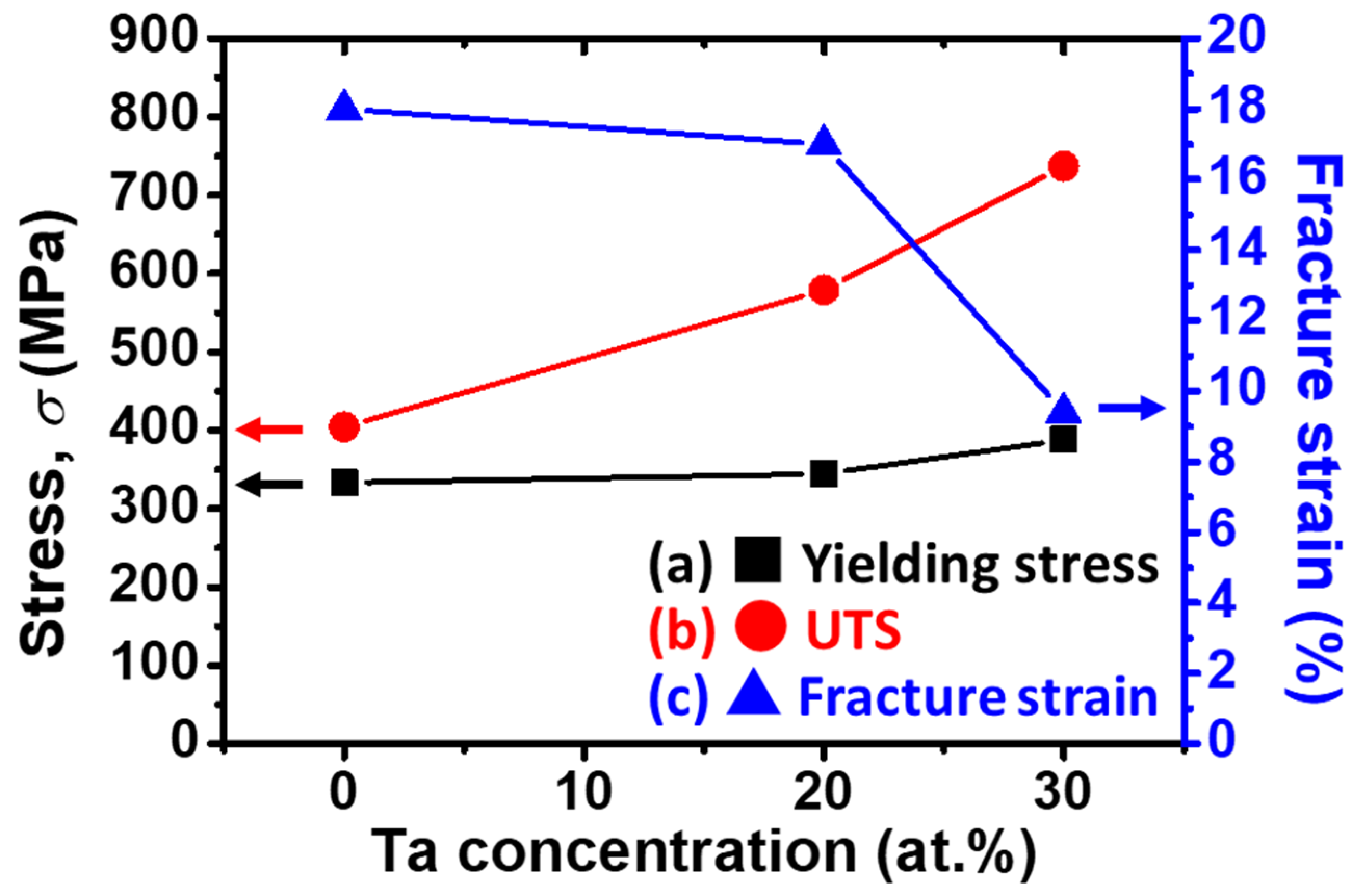

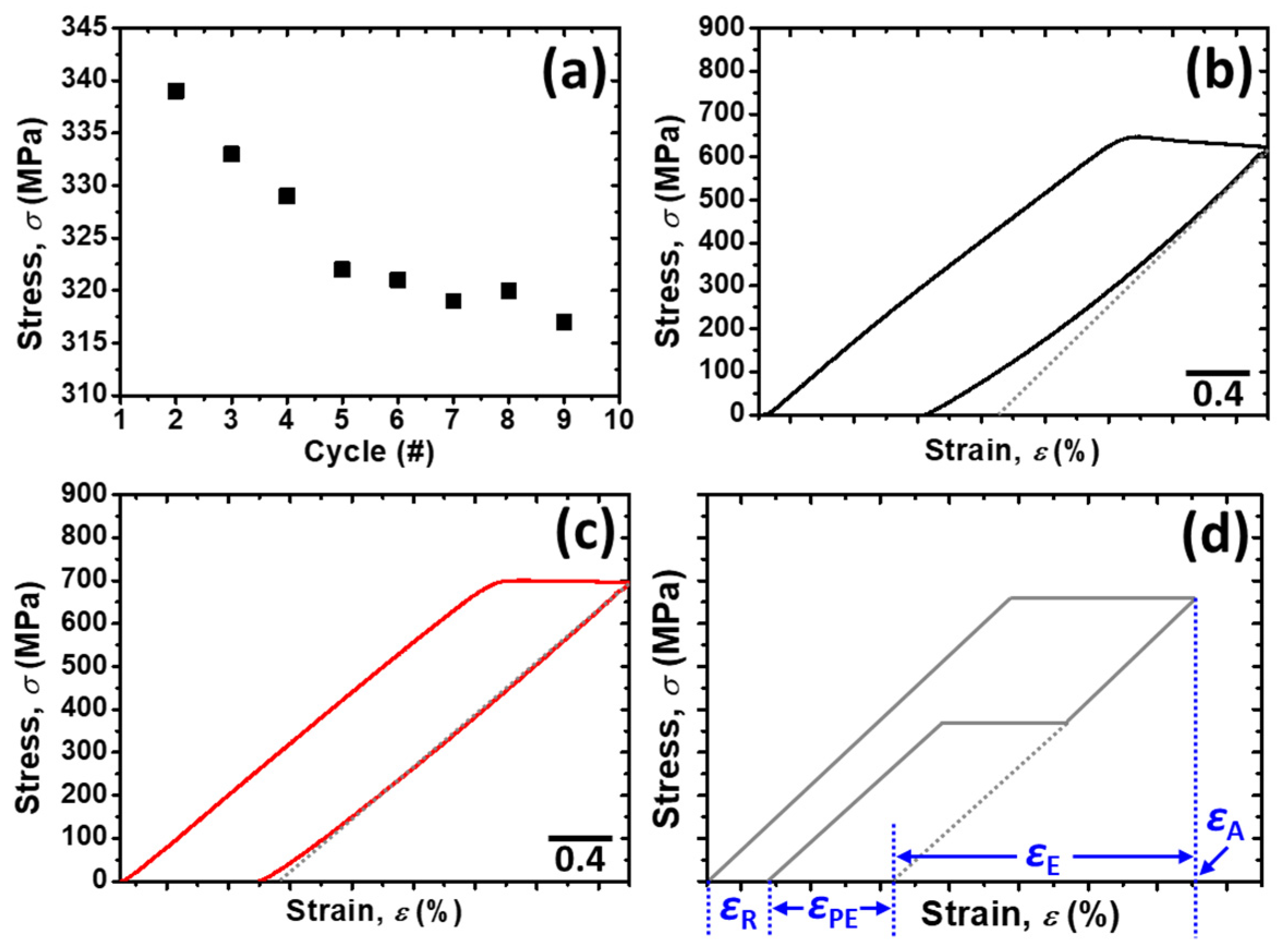
Publisher’s Note: MDPI stays neutral with regard to jurisdictional claims in published maps and institutional affiliations. |
© 2021 by the authors. Licensee MDPI, Basel, Switzerland. This article is an open access article distributed under the terms and conditions of the Creative Commons Attribution (CC BY) license (https://creativecommons.org/licenses/by/4.0/).
Share and Cite
Chiu, W.-T.; Fuchiwaki, K.; Umise, A.; Tahara, M.; Inamura, T.; Hosoda, H. Investigations of Effects of Intermetallic Compound on the Mechanical Properties and Shape Memory Effect of Ti–Au–Ta Biomaterials. Materials 2021, 14, 5810. https://doi.org/10.3390/ma14195810
Chiu W-T, Fuchiwaki K, Umise A, Tahara M, Inamura T, Hosoda H. Investigations of Effects of Intermetallic Compound on the Mechanical Properties and Shape Memory Effect of Ti–Au–Ta Biomaterials. Materials. 2021; 14(19):5810. https://doi.org/10.3390/ma14195810
Chicago/Turabian StyleChiu, Wan-Ting, Kota Fuchiwaki, Akira Umise, Masaki Tahara, Tomonari Inamura, and Hideki Hosoda. 2021. "Investigations of Effects of Intermetallic Compound on the Mechanical Properties and Shape Memory Effect of Ti–Au–Ta Biomaterials" Materials 14, no. 19: 5810. https://doi.org/10.3390/ma14195810
APA StyleChiu, W.-T., Fuchiwaki, K., Umise, A., Tahara, M., Inamura, T., & Hosoda, H. (2021). Investigations of Effects of Intermetallic Compound on the Mechanical Properties and Shape Memory Effect of Ti–Au–Ta Biomaterials. Materials, 14(19), 5810. https://doi.org/10.3390/ma14195810






